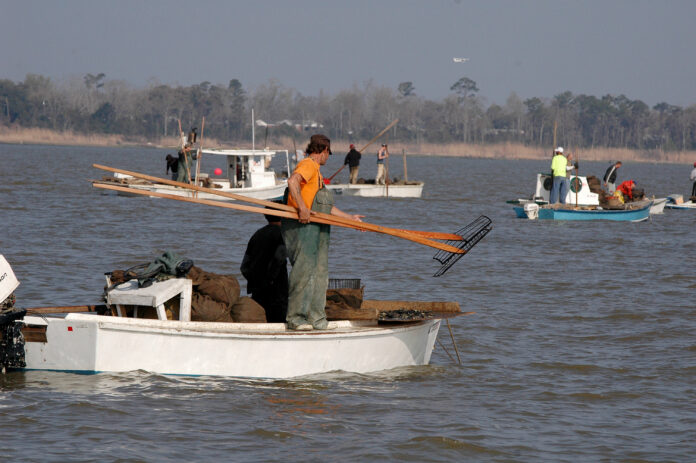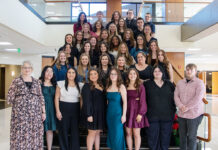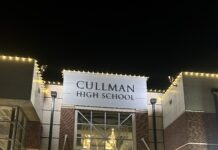
MONTGOMERY, Ala. – With the conflict among deer hunting factions at an all-time low, Alabama Department of Conservation and Natural Resources (ADCNR) Commissioner Chris Blankenship used last weekend’s Conservation Advisory Board meeting in Huntsville to update the Board on the numerous projects in the state under ADCNR oversight.
A milestone was surpassed this year when projects funded through the Deepwater Horizon oil spill settlement exceeded $1 billion, Commissioner Blankenship said. ADCNR’s Deepwater Horizon Restoration Coordinator, Amy Hunter, and her staff oversee the projects funded by the settlement.
“The big takeaway is we have $1 billion, $29 million in projects underway in Mobile and Baldwin counties that we are managing through our Deepwater Horizon Section,” Commissioner Blankenship said. “That is 176 individual projects. That’s a lot of money and a lot of work going on. We have six people in that section, and they’re doing a very good job of managing projects that will make generational changes on the Gulf Coast.
“We never want to go through another Deepwater Horizon event, where 11 lives were lost. It was a terrible, terrible event for our coast. However, we’re trying to do good work with the money that came from that settlement.”
Among those projects are ones to replenish and protect Alabama’s living coastal and marine resources.
“That includes restoration of oysters and oyster reefs,” Commissioner Blankenship said. “We’re building about $30 million in artificial reefs. We’re increasing funding for research for stranding response for marine mammals and sea turtles, conservation of bird nesting and foraging habitat as well as construction of a wildlife rehabilitation center and sea turtle triage facility in Orange Beach.”
Another goal of the funding is to support and enhance community resilience during environmental or economic crises. The $65 million in projects includes the construction of the Auburn University Gulf Coast Engineering and Research Center in Orange Beach to improve engineering in the coastal environment. Also, a new Alabama Department of Environmental Management (ADEM) office is under construction on the coast. The Alabama Seafood Commission is funded as well as Fairhope’s Working Waterfront and Green Space initiative.
“Resilience is important for all of our state but particularly our coastal areas,” Commissioner Blankenship said. “We’re working to make us more resilient during storms or drought or economic downturns, things that make our communities stronger when we have negative impacts in our state.
“As an aside, Governor (Kay) Ivey, by executive order, created a resilience council just a few weeks ago, and the Commissioner of the Department of Conservation is one of the members.”
Funding will also be used to provide and enhance economic development and infrastructure. The 11 projects, totaling $197.5 million, include the construction of Africatown Welcome Center, which will house a portion of the Clotilda. The Clotilda, discovered in the Mobile-Tensaw Delta, was the last slave ship to transport slaves from Africa to the United States. In another key project, the Port of Mobile has constructed a roll-on, roll-off facility that will facilitate the export of cars and trucks that are built in Alabama. Road improvements in Baldwin County are also included in this funding.
About $401 million is being used to restore, conserve and enhance habitat in coastal Alabama.
“This is primarily land acquisition,” Commissioner Blankenship said. “So far, we have acquired more than 13,000 acres of land in coastal Alabama to protect and provide recreational access. That includes the west end of Dauphin Island, Grand Bay Savanna, Pilot Town on Fort Morgan, Gulf Highlands property on Fort Morgan, which is one of the last undeveloped areas of the beach that was not part of Fort Morgan or the Bon Secour National Wildlife Refuge. It also includes multiple parcels in Weeks Bay, parcels at Dauphin Island, Oyster Bay, and we have purchased three parcels in the Three Rivers area that we have transferred to the Bon Secour National Wildlife Refuge.”
Land acquisition also includes tracts along the Perdido River watershed to provide a wildlife corridor from the Perdido River Wildlife Management Area to the Lillian Swamp Forever Wild property.
“We have been working for the past six years to connect those wildlife management areas,” Commissioner Blankenship said. “It will be a distinct wildlife corridor with about 50 miles of river frontage.
“When that work is done, we will have well over 30,000 acres along the Perdido River for public access, hunting, hiking, canoe trails and river frontage from near the headwaters all the way to Perdido Bay in public ownership. We have used more than eight different funding sources to acquire this property. This shows how working together with our divisions and the Deepwater Horizon Section has been really successful at putting all this together for the people of Alabama for perpetuity.”
Another $159 million is committed to improving water quality in coastal Alabama through sewer and septic tank mitigation.
“We are working with the utilities to avoid sanitary sewer overflows to improve water quality,” Commissioner Blankenship said. “Using Deepwater Horizon and GOMESA (Gulf of Mexico Energy Security Act) funding, we have done several septic to sewer conversions in the coastal areas, like Fowl River, Grand Bay and Bayou La Batre, that are really close to the water.”
The effort to provide and enhance recreation and public access will receive $147 million in funding.
“During the oil spill, it wasn’t just the environment that was impacted, it was also the people,” Commissioner Blankenship said. “We lost recreational access to the beaches, fishing and a lot of other activities. As part of the Natural Resource Damage Assessment (NRDA), a large portion is dedicated to recreational use to include projects at our State Parks. Gulf State Park and its 28 miles of trails is probably the most obvious example of that. But we are also expanding the campground at Meaher State Park on Mobile Bay, a trail on Fort Morgan, and blueway and greenway development in the City of Mobile. That also included improvements to Gulf State Park Pier, which was finished just as Hurricane Sally hit. And the Fort Morgan Pier was rebuilt. Scott Bannon and Marine Resources oversaw that construction.”
Commissioner Blankenship said the $39 million in GOMESA funding was received this year and projects will be announced by the Governor this summer. Previously, more than $120 million in GOMESA funding has been used for multiple boating access improvements, land acquisition, other public access for parks on the water in Mobile, Spanish Fort and Daphne, water quality improvements, environmental research and economic development. Additionally, beach nourishment projects will begin in late summer for Dauphin Island, Gulf Shores, Orange Beach and Gulf State Park.
Several years ago, Governor Ivey created Innovate Alabama, an entity with the goal of attracting people, businesses and manufacturing to the state. Commissioner Blankenship is the chair on that entity’s Council on Outdoor Recreation.
“Innovate Alabama was set up to differentiate us from other states, to attract or retain workers and improve the quality of life in Alabama,” he said. “One of the things that came out of that was outdoor recreation and the beauty of our state.
“We have a lot of woods and water in our state, and that gives us great opportunities for recreational access. It is a way to differentiate us from other states.”
Commissioner Blankenship said the council decided to expand its reach by creating the 19-member Outdoor Recreation Advisory Roundtable to include a variety of recreational activities and geographical areas. Tim Wood of Selma, a Conservation Advisory Board member, also serves on the roundtable.
“We have a list of 13 recommendations that we will take to Innovate Alabama at its June meeting on things that can be done to take advantage of our assets in Alabama,” Commissioner Blankenship said.
Commissioner Blankenship said construction is underway at many Alabama State Parks across the state, using the funds provided by the bond issue that was overwhelmingly approved by voters last year. He said some areas of the parks may be closed during the construction.
“I tell people, ‘Pardon our progress. Once we get this done, you’re going to be really pleased with the finished project,’” he said. “As part of the renovations of the parks, we hosted a public meeting at Northport for Lake Lurleen State Park to get input from the public about what they wanted to see when we do the renovations at that park. It is going to be pretty much a rebuild at that park. I thought we might have 20 or 30 people show up, but we had more than 100 people show up at the community center to voice their opinions on what they want to see at the park. In fact, they canceled the church service on Wednesday night at the Baptist church so everybody could attend the meeting. We were happy to see so much interest in Lake Lurleen State Park.”
The Board was also updated on Alabama’s red snapper season with the announcement of the 85-day season for for-hire (charter) vessels from June 1 through August 25. The Gulf of Mexico Fishery Management Council will meet June 5-8 in Mobile, where the council will consider a proposal to increase the quota for the private recreational fishermen. The private recreational snapper season will consist of four-day weekends, Friday through Monday, opening on May 26 and continuing until the quota is projected to be met.
“If approved, that would be about a 110,000-pound increase before the end of the year, which would be about a 20% increase in our quota,” Commissioner Blankenship said. “Our quota was reduced by about half this year from recent years, and this increase would help us get some of that back, which should give us a long, successful season for red snapper this year.”





















